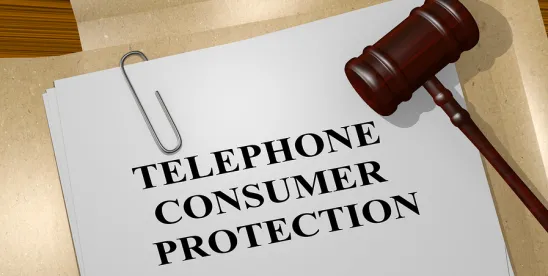In a much-anticipated decision, the US Court of Appeals for the DC Circuit has ruled on the Federal Communication Commission’s 2015 Declaratory Order on the Telephone Consumer Protection Act, focusing on autodialing equipment, reassigned phone numbers, and revocation of consent. This edition of Morgan Lewis Retail Did You Know? highlights that this decision, and changes to the Federal Communications Commission under the Trump administration, may have the effect of narrowing liability for retailers that call or text customers, although the decision still leaves companies with uncertainty.
Background
The DC Circuit recently handed down its long-awaited decision in ACA International v. Federal Communications Commission. This decision will be of great interest to retailers who call or text customers, employees, or other individuals. The court reviewed challenges to several aspects of the Federal Communication Commission’s (FCC’s) 2015 Declaratory Order, namely (1) its definition of an automatic telephone dialing system (ATDS); (2) the reasonableness of the one-call “safe harbor” for calls placed to reassigned numbers; (3) revocation of consent; and (4) the FCC’s exemption for certain healthcare-related calls. The DC Circuit set aside the FCC’s interpretation of ATDS and the FCC’s treatment of reassigned numbers as a whole, and upheld the FCC’s 2015 ruling that a called party may revoke consent at any time and through any reasonable means as well as the narrow exemption for certain healthcare-related calls.
Importantly, we highlight that the leadership of the FCC has changed since the adoption of the FCC’s 2015 order interpreting the Telephone Consumer Protection Act (TCPA). The current chairman of the FCC, Ajit Pai, who was appointed by President Donald Trump, dissented from what was the majority opinion of a Democratic-led FCC at the time the FCC adopted the 2015 order. Republican Commissioner Michael O’Rielly also dissented from the FCC’s 2015 order. As detailed herein, both of their dissents were cited by the court in vacating much of the FCC’s 2015 order. Significantly, the FCC is now composed of a three-member Republican majority where two—Mr. Pai and Mr. O’Rielly—have already expressed their antipathy for a broad interpretation of the TCPA, and some of their legal positions have been affirmed by the DC Circuit. Parties currently threatened with or embroiled in TCPA-related litigation should seriously consider seeking relief directly from the FCC as part of a comprehensive litigation strategy. Moreover, we expect that the current composition of the FCC would consider expanding the narrow exemption granted by the FCC in the 2015 Order and upheld by the court. While the court found that the FCC’s exemption for certain healthcare-related text messages and calls was reasonable, its finding would not bar expansion of the exemption by the current majority of the FCC.
Key Aspects of the DC Circuit’s Decision
Meaning of an Automatic Telephone Dialing System. The TCPA generally regulates calls or text messages using an ATDS. The statute defines an ATDS as “equipment which has the capacity – (A) to store or produce telephone numbers to be called, using a random or sequential number generator; and (B) to dial such numbers.”[1] The 2015 FCC order declined to limit the meaning of “capacity” to “present capacity,” instead construing “capacity” to encompass “potential functionalities” and “future possibility” as well.[2] The FCC acknowledged that its definition could sweep in all smartphones. The DC Circuit set aside the FCC’s interpretation as an unreasonably expansive reading of the statute.[3]
The court wrote that the FCC’s decision leaves affected parties “in a significant fog of uncertainty about how to determine if a device is an ATDS so as to bring into play the restrictions on unconsented calls.”[4] Although it clearly rejected the FCC’s interpretation of “capacity,” the court did not provide guidance on an affirmative definition of the term; instead, it found that any interpretation of “capacity” that includes smartphones is an unreasonable reading of the TCPA. The court found that the FCC’s order “cannot reasonably be understood to support the conclusion that smartphones fall outside the TCPA’s autodialer definition. . .”[5] Some may try to construe this language narrowly to argue that the court held that an ATDS cannot be a cellphone. But such a narrow interpretation ignores the fundamental finding by the court that took issue with the FCC’s interpretation such that smartphones’ “inherent ‘capacity’ to gain ATDS functionality by downloading an app” is an unreasonable and “impermissibly expansive” interpretation of the TCPA. Accordingly, any argument based on the capacity of a particular type of hardware to be modified so that it can generate random or sequential numbers is called into question by the court’s finding.
Significantly, the court also rejected the FCC’s prior findings in 2003 and 2008 that predictive dialers constitute an ATDS. The FCC argued that the court lacked jurisdiction to review these prior findings since there was no timely appeal of the FCC’s 2003 and 2008 orders. The court ruled that the FCC’s 2003 and 2008 rulings were reviewable because parties sought both clarification and a rulemaking on the definition of an ATDS, the FCC’s “prior rulings left significant uncertainty about the precise functions an autodialer must have the capacity to perform”, and the 2015 FCC order purported to clarify the definition of an ATDS. Due to the FCC’s lack of clarity on which functions qualify a device as an ATDS, the court also set aside the FCC’s prior findings with respect to predictive dialers.
Interestingly, the court also appeared to endorse Mr. O’Reilly’s view in his dissent to the 2015 FCC order that even equipment with the present capacity to function as an ATDS does not satisfy the definition of an ATDS unless that functionality is actually used to place a call or initiate a message.[6] Under this interpretation, a smartphone would not violate the TCPA unless it was configured to function as an ATDS and that functionality was actually used to place a call or initiate a message. But the court notes that the petitioners did not raise this issue on appeal and so it made no finding with respect to this argument.
In another passage that may impact the broader interpretive issues under the TCPA that were not addressed by the court, it cautioned against assuming that Congress meant for the definition of an ATDS to apply to all of the phone equipment that has developed since the inception of the TCPA: “Congress need not be presumed to have intended the term [ATDS] to maintain its applicability to modern phone equipment in perpetuity, regardless of technological advances that may render the term increasingly inapplicable over time.”[7] The court’s stance is significant for emerging TCPA issues, because it runs counter to arguments often made by consumer advocates and plaintiffs’ attorneys about the need for the TCPA to be interpreted in an evolving manner to encompass new technologies.
Reassigned Numbers. Although the DC Circuit agreed with the FCC’s interpretation of “called party” to mean “current subscriber,” it nonetheless struck down the FCC’s ruling on reassigned numbers on the basis that the FCC’s “one-call safe harbor” was arbitrary. In the 2015 order, the FCC implemented a one-call safe harbor, which allows a caller who lacks knowledge to avoid liability for the first call (or text message) to a wireless number following reassignment because the caller is reasonably relying on the previous subscriber’s consent. The court found that determination was arbitrary because a caller’s reliance on a previous subscriber’s consent does not necessarily cease to be reasonable after a single, post-reassignment call.[8] The court appeared to endorse the “reasonable reliance” standard for reassigned numbers while rejecting the one-call safe harbor. In fact, the court specifically states that leaving the interpretation of “called party” to refer to the new subscriber would be unacceptable because it would make the caller “strictly liable for all calls made to the reassigned number, even if she has no knowledge of the reassignment.”[9]
The court also signaled that the FCC should take the lead to solve the problem of reassigned phone numbers, noting the FCC’s request for comments on potential methods for “requir[ing] service providers to report information about number reassignments for the purposes of reducing unwanted robocalls.”[10] Many of the FCC proposals envision creating a repository of information about reassigned wireless numbers as a means to solve this problem.[11]
Ultimately, while the court’s decision provides significant relief to callers, the decision still emphasizes the need for callers to update lists and work towards addressing the problem of reassigned numbers. The key to avoiding liability in these situations will be to establish a reasonable process for identifying reassigned numbers, given available resources and technology.[12]
Revocation of Consent. Though it is undisputed that consumers who have consented to receiving calls otherwise forbidden by the TCPA can revoke their consent, the statute does not elaborate on the processes by which consumers may validly revoke consent.[13] The FCC’s 2015 order concluded that a “called party may revoke consent at any time and through any reasonable means.”[14] The DC Circuit upheld the FCC’s 2015 ruling on revocation of consent, unpersuaded by petitioners’ objection that the FCC’s “any reasonable means” approach, in lieu of standardized revocation procedures, was unduly uncertain, arbitrary and capricious.[15]
The court noted that establishing clearly-defined and simple opt-out methods is a way in which callers can protect themselves from liability: “callers will have every incentive to avoid TCPA liability by making available clearly-defined and easy-to-use opt-out methods. If recipients are afforded such options, any effort to sidestep the available methods in favor of idiosyncratic or imaginative revocation requests might well be seen as unreasonable.”[16] In addition, the court stated that nothing in the FCC’s 2015 order should be understood to speak to parties’ ability to contractually agree upon revocation procedures.[17] Thus, the court offers two avenues that could be helpful to companies in avoiding TCPA litigation: (1) create clear and easy revocation methods and communicate those methods to consumers; and (2) negotiate the terms of revocation by contract. However, left ambiguous is whether defining such a method in a linked privacy policy or terms of service would qualify as a “revocation procedure by mutual agreement.”
Scope of the Healthcare Exemption. The FCC is allowed by statute to provide certain exemptions for calls and text messages that would otherwise violate the TCPA. In the 2015 order, the FCC granted an exemption for non-telemarketing, healthcare-related calls for which there is exigency and have a healthcare treatment purpose. The FCC went on to enumerate particular calls as exempt explicitly excluding calls that constitute telemarketing, solicitation, or advertising content, or which address accounting- or billing-related information. Some petitioners argued that this exemption was too limited and unreasonable. Pointing to the Health Insurance Portability and Accountability Act (HIPAA), these petitioners argued that if HIPAA allowed the call, the FCC was preempted from finding that the TCPA prohibited it or, alternatively, that the exemption fashioned by the FCC was arbitrary and capricious. The court disagreed.
The court found that the FCC’s 2015 order did not restrict communications that HIPAA permits to flow freely. Instead, the FCC “declined to make certain exchanges even less burdensome than they would have been by default.” The court also rejected petitioners’ arguments that the exemption set out in the 2015 order was arbitrary and capricious because it is narrower as applied to calls placed to wireless subscribers compared with those placed to wireline consumers. The court noted that the TCPA itself make such a distinction so it is reasonable for the FCC to do the same. We expect that this is one area where the healthcare industry could have success with the present FCC should it seek to expand this exemption.
Given the DC Circuit’s decision, it seems likely that the FCC will—at a minimum—reconsider and provide additional guidance on the meaning of an ATDS and reassigned numbers. As the composition of the FCC has changed, there is hope that any new decisions will be markedly different from those that came out in 2015. In the meantime, courts that have long awaited this decision, including those that have stayed cases pending this decision, may need to further stay proceedings until the FCC readdresses these issues.
[1] 47 USC § 227(a)(1).
[2] 2015 Declaratory Ruling, 30 FCC Rcd. at 7974, 7975 ¶¶ 16, 20.
[3] ACA Int'l v. Fed. Commc'ns Comm'n, 15-1211, 2018 WL 1352922, at *9 (DC Cir. Mar. 16, 2018).
[4] ACA Int’l, 2018 WL 1352922 at *12.
[5] Id. at *9.
[6] See id. at *13.
[7] Id. at 8.
[8] Id. at *15.
[9] Id.
[10] Id. at 17 (citing Advanced Methods to Target and Eliminate Unlawful Robocalls, Second Notice of Inquiry, 32 FCC Rcd. 6007, 6010 ¶ 9 (2017)).
[11] See id. at 6012-13 ¶¶ 15-19.
[12] Id. at 6012-13 ¶¶ 15-19.
[13] 30 FCC Rcd. at 7996 ¶ 62.
[14] Id. at 7989-90 ¶ 47.
[15] ACA Int’l, 2018 WL 1352922 at *18.
[16] Id.
[17] Id.




 />i
/>i
